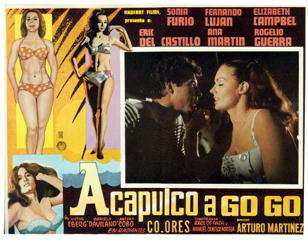Acapulco a go go
(Radeant Films, 1966) Exec Prod: Raúl de Anda Serrano; Dir: Arturo Martínez; Scr: Raúl de Anda G., Manuel Canseco Noriega; Photo: Fernando Colín; Music: Enrico Cabiati; Prod Mgr: José L. Murillo; Asst Dir: Tito Novaro; Film Ed: Raúl J. Casso; Art Dir: Artis Gener; Camera Op: Raúl Domínguez; Makeup: Antonio Ramírez; Dialog Rec: Enrique L. Rendón; Re-rec: Heinrich Henkel; Sound Ed: Sergio Soto; Union: STIC; Eastmancolor and Mexiscope
CAST: Sonia Furió (Celia), Fernando Luján (Robert), Elizabeth Campbell (Marian), Eric del Castillo (Mario Treviño), Ana Martín (Rita), Rogelio Guerra (Jorge), Víctor Eberg (Renato, artist), Marcela Daviland (Margaret Reynolds), Arturo Cobo "Cobitos" (waiter), Arturo Silva (waiter), Mayté Carol (Beba Sandoval?), Mario Sevilla (Lic. Vélez), Tito Novaro (Mario's partner), Wally Barrón (police cmdte.), Federico del Castillo (police agent), Julio Aldama and Rodolfo de Anda (men dancing in disco), El Klan (band--heard on soundtrack only)
NOTES: this movie's title is somewhat misleading--while some action takes place in the "Acapulco a Go Go" discoteque, this is not really a youth-oriented, rock and roll musical. Instead, it is a multi-story melodrama (soap opera veteran Manuel Canseco Noriega's name in the credits should be a tip-off). The soundtrack does include seven songs performed by "El Klan," including "Gloria," "Woolly Bully," and "Hang on Sloopy," which accompany footage of Ana Martín as a go-go dancer and scenes of other people dancing in the disco, but these are completely irrelevant to the plot and tone of the movie as a whole.

The three stories are intertwined, but I will describe them separately. Marian is a gringa (actually, her father was Mexican but she was born in the USA) who is staying at her family's home in Acapulco. She picks up lanchero (boat boy) Jorge and they have sex on the beach. Marian's step-mother Margaret arrives and says she is renting out the house and taking Marian and her brother Robert back to Chicago. Marian begins another affair with artist Renato, who paints her in the nude. They hatch a plot to kill Margaret. Marian brings Jorge in on the scheme, offering to pay him a large sum of money. Margaret, Marian, and Jorge go out on Renato's yacht one evening; Margaret says she has changed her mind and is going to give Marian and Robert their trust fund money, but the drunken Jorge pushes her overboard and she drowns. Renato says Marian must marry him in exchange for his silence.
Robert, Marian's brother, falls in love with go-go dancer Rita. She has a large, extended family and doesn't want an affair. Robert proposes to Rita; he will marry her as soon as he returns from the USA.
Mario is an architect in charge of a large construction project in Acapulco. He works day and night, which frustrates his wife Celia. She wants to have fun, but he is either working or is too tired. What she doesn't know is that he has a terminal illness and is racing the clock to make enough money for her to live on after he dies. Celia goes to the disco alone and flirts with Jorge. He rapes her on the beach. Mario commits suicide by jumping off a cliff. Celia is arrested for his murder, but Mario's suicide note--which was mislaid at first--clears her.
Jorge is brought in under suspicion of Mario's murder, but he thinks they are referring to Margaret's death. He confesses and implicates Marian, who is arrested at the airport.
Unless you were expecting a teen musical, Acapulco a Go Go is actually a fairly entertaining picture, with a decent script and good performances. Elizabeth Campbell is ravishing as usual, and has a number of discreet, show-nothing nude scenes (the artist paints her nude, but when we see his finished work, it is half-abstract). She is quite convincing as the selfish Marian, who pretends to agree with her stepmother to lull the older woman into a false sense of security, then has her murdered, needlessly as it develops. Afterwards, Marian blames Renato for "tricking" her into the murder plot, but when she is arrested at the airport, she only tells her brother Robert that there is "some problem with my papers," so she'll have to take a later flight. Víctor Eberg does a good job as the crazy-but-clever Renato, who wears a Roman toga while he paints and manipulates Marian for his own ends.
The Furió-del Castillo story is given relatively shorter shrift, but Furió is very good as the sexy wife who loves her husband but is bored into deceiving him (she claims she is going to the movies with a female friend, but visits the disco alone). She even responds to Jorge's rape, after struggling for a time, and says nothing to her husband afterwards.
The least of the stories is the Robert-Rita romance, which is really thin and has no dramatic edge at all. Fernando Luján gets to do his drunk act and Ana Martín looks great while she dances on stage, but, aside from the fact that this is the only story with a happy ending, this sub-plot is quite expendable.
Acapulco a Go Go and La muerte en bikini were shot back-to-back by the same crew, but the films are not related to each other and in fact only share a few cast members.
Back to the Elizabeth Campbell Page.
This review posted 31 Dec 2000 by David Wilt (dwilt@umd.edu)